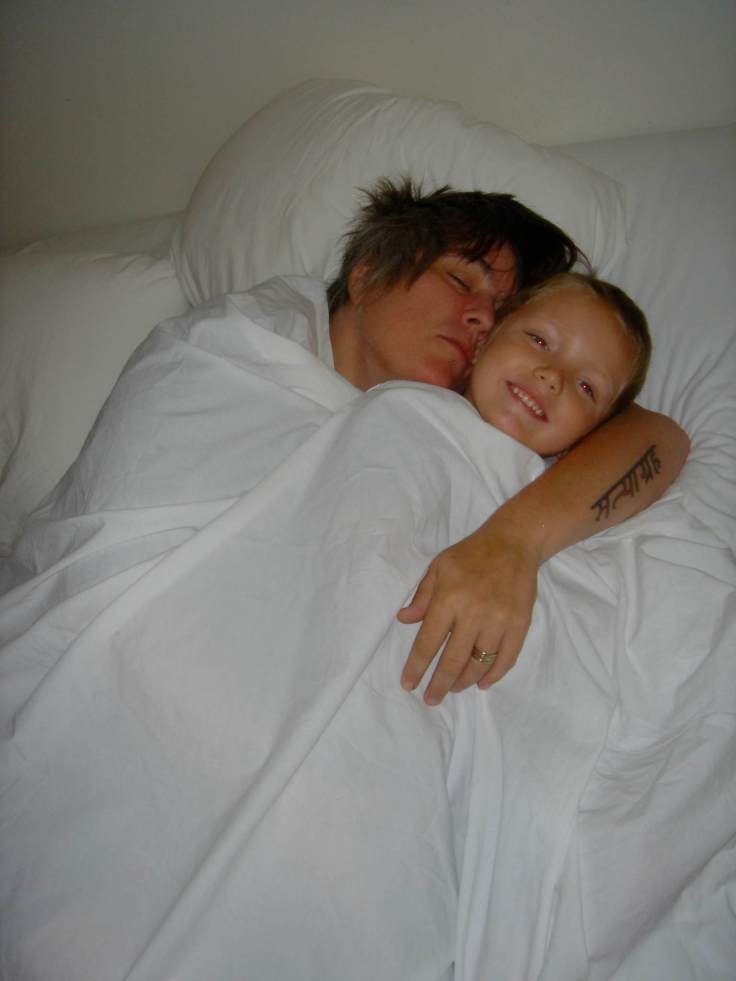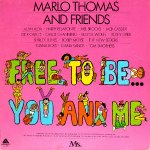Six-thirty comes early when you go to bed at two.
Last night, my wife’s heavy metal band played to a packed house of head-banging lezzies. Of course we had to go out for triumphant post-show pancakes. Now it’s my turn to take our son to school, and I’m feeling decidedly less celebratory.

On the clock radio, an NPR announcer is explaining, for the umpteen billionth time, about credit default swaps. I think I understand: as a mother, I’m always struggling to balance love, work, creativity, and the mundane obligations of domestic life. I know the temptation of a little creative accounting. Right now, I’m trying to leverage the possibility that I might know the location of my son’s shoes for ten more minutes of sleep.
 I roll out of bed, start the coffee, and search the living room for my hat. Blue hair seemed like a great idea when I was plotting to be the belle of the freak fest, but this morning I have to walk the gauntlet of parents between the car and the door of my son’s kindergarten class. Four hours of sleep have not prepared me to make small talk with PTA peeps.
I roll out of bed, start the coffee, and search the living room for my hat. Blue hair seemed like a great idea when I was plotting to be the belle of the freak fest, but this morning I have to walk the gauntlet of parents between the car and the door of my son’s kindergarten class. Four hours of sleep have not prepared me to make small talk with PTA peeps.
After the drop off, I call the dentist’s office and reschedule my son’s appointment. I tell them Waylon has the flu, which is a lie; I don’t want to pay the $25 cancellation fee. I feel a tiny tickle of remorse for not prioritizing dental hygiene, but I have to get some writing done today. If I don’t, maternal martyrdom will inevitably lead to greater crimes and grander regrets.
Earnest Hemingway wrote 500 words a day. Once Papa reached the magic number, he was free to drink, fuck, visit Gertrude Stein, whatever. I was immediately drawn to this measure of creative productivity. It’s a humane yardstick for when to say “enough” and move on. Once Mama hits 500 words, I’m free to do all the other shit I have to do.
At 468 words, I stop to put the dishes in the dishwasher. As I’m bending down to pour detergent in the little trough, my gaze hovers for a moment at the baseboard, where layers of congealed dust are threatening to become fur. I don’t allow myself to intervene, even though I recently read a study that found a positive correlation between an orderly home and childhood literacy. The authors asked mothers to rank their homes on the “Chaos, Hubbub, and Order Scale”–an instrument that I had previously imagined to exist only in the sadistic arsenal of my superego.
Intellectually, I consider this study ludicrous, its biases completely transparent. However, now that the “Chaos, Hubbub, and Order Scale” has been confirmed to exist outside my mind, its Victorian standard keeps coming back to haunt me. “What about the child?” it whispers as I walk past the mountain of unfolded laundry. Waylon’s blue eyes seem to plead from every dust bunny.
I don’t want to succumb to a full-blown domestic project, so I escape upstairs to check on my wife, Katy. She’s still in bed, totally spent from last night’s show. The blinds are drawn, and the floor is littered with cough drop wrappers. I sit on the side of the bed and try to stroke her brow, but she recoils. It’s as if rock-n-roll has flayed her skin and exposed raw nerves. Attempts at conversation elicit pained grimaces and a few faint moans. Then she pulls the covers over her head and goes back to sleep.
 I’m frustrated and self-conscious. When Waylon was born, Katy’s hometown paper ran a front-page story titled “SHOULD WAYLON HAVE TWO MOMMIES?” Although I am generally not in favor of public referendums on my family, on a day like today, when I’m cancelling pediatric dental appointments and Katy is in a musically-induced coma, my mind tends to compose its own headline: “SHOULD SLOVENLY ARTISTIC TYPES HAVE BABIES?”
I’m frustrated and self-conscious. When Waylon was born, Katy’s hometown paper ran a front-page story titled “SHOULD WAYLON HAVE TWO MOMMIES?” Although I am generally not in favor of public referendums on my family, on a day like today, when I’m cancelling pediatric dental appointments and Katy is in a musically-induced coma, my mind tends to compose its own headline: “SHOULD SLOVENLY ARTISTIC TYPES HAVE BABIES?”
I have to remind myself that performance consumes energy in violent, catastrophic bursts rather than moderate daily units. Around here, the impact is brief, albeit extreme. In a couple of days, Katy will be taking Waylon to school and loading the dishes while I’m holed up in my room, trying to churn out 500 words.
Since grocery shopping is usually Katy’s chore, tonight’s dinner will be take-out. I grab some tacos on the way home from work. As we unpack the food from greasy paper bags, we discuss the big news from kindergarten: Waylon got his conduct card changed from green to yellow for kissing Tina in the reading loft. In Waylon’s recounting of the story, it’s Joseph who was really at fault, for “telling everybody.”
“Who else have you kissed?” Katy asks.
“Oh…just Joe, and Charlie…and Frank.” A few minutes later, I get a text from Frank’s mom: “Rumor has it that Waylon got in trouble for kissing Tina. LOL.” I contemplate telling her that Tina’s not the only one, but decide to wait until after she babysits for me next weekend.
We eat dessert in the back yard; Waylon takes a bite of ice cream, swallows, runs to the playscape, climbs the latter, jumps to the trapeze, swings around 180°, and then comes back to the picnic table for another bite. His path is cluttered with plastic toys and garden tools. All the junk Katy shoveled out of the car in order to transport equipment to the rock show last night is jumbled in a trash bag on the doorstep. The bag might sit there a week or even a month before its contents are missed and sorted.
Surveying our disorderly domain, I force myself to focus on the bright side of that study about childhood reading and household order: at least one of the questions on the Chaos, Hubbub, and Order Scale asked about a regular bedtime routine. In my optimistic moments, I choose to interpret routine as ritual. I can’t promise Waylon cleanliness, but I can promise him ritual.
7:30 is story time. Waylon snuggles against me in the bed, and we take turns reading to each other. After that, Katy leads the bedtime song, a customized version of “The Farmer in the Dell.” In this version, the wife takes a wife and all kinds of strange pairings ensue: a block with a Lego, a horse with a worm, and (in a nod to E.B. White) a pig with a spider.
The song has to end the same way every night, or else Waylon won’t go to sleep. The spider takes the cheese. And then there’s a Freddie Merucury-style chant:
“Hi-ho the derry-o, the spider takes the cheese and makes a holey-wolly, holey-wolly, hole, hole, hole.”
Holey-wolly, holey-wolly, hole, hole, whole. This post was originally posted under the title “The Chaos, Hubbub and Order Scale.”
This post was originally posted under the title “The Chaos, Hubbub and Order Scale.”
P.S. A lot of people have asked for a link to the original “Should Waylon Have Two Mommies” article.
Butch County photo by John Leach of johnleachphoto.com. Used with permission.


